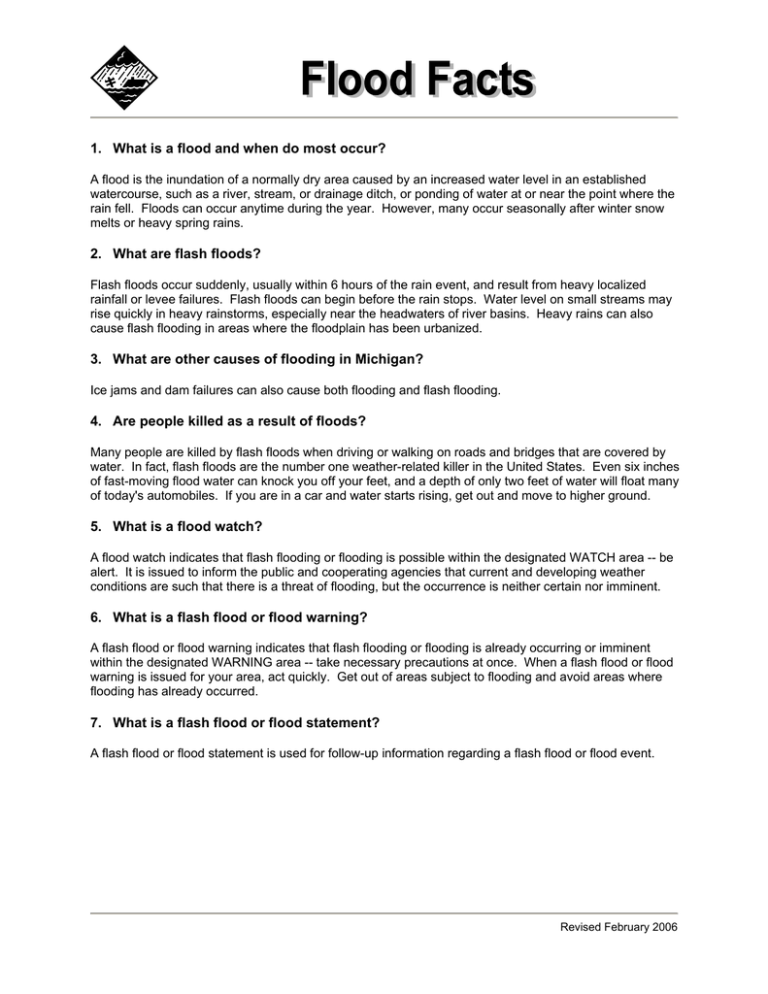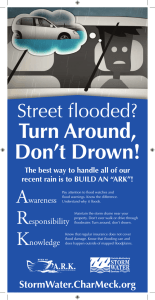1. What is a flood and when do most occur?
advertisement

1. What is a flood and when do most occur? A flood is the inundation of a normally dry area caused by an increased water level in an established watercourse, such as a river, stream, or drainage ditch, or ponding of water at or near the point where the rain fell. Floods can occur anytime during the year. However, many occur seasonally after winter snow melts or heavy spring rains. 2. What are flash floods? Flash floods occur suddenly, usually within 6 hours of the rain event, and result from heavy localized rainfall or levee failures. Flash floods can begin before the rain stops. Water level on small streams may rise quickly in heavy rainstorms, especially near the headwaters of river basins. Heavy rains can also cause flash flooding in areas where the floodplain has been urbanized. 3. What are other causes of flooding in Michigan? Ice jams and dam failures can also cause both flooding and flash flooding. 4. Are people killed as a result of floods? Many people are killed by flash floods when driving or walking on roads and bridges that are covered by water. In fact, flash floods are the number one weather-related killer in the United States. Even six inches of fast-moving flood water can knock you off your feet, and a depth of only two feet of water will float many of today's automobiles. If you are in a car and water starts rising, get out and move to higher ground. 5. What is a flood watch? A flood watch indicates that flash flooding or flooding is possible within the designated WATCH area -- be alert. It is issued to inform the public and cooperating agencies that current and developing weather conditions are such that there is a threat of flooding, but the occurrence is neither certain nor imminent. 6. What is a flash flood or flood warning? A flash flood or flood warning indicates that flash flooding or flooding is already occurring or imminent within the designated WARNING area -- take necessary precautions at once. When a flash flood or flood warning is issued for your area, act quickly. Get out of areas subject to flooding and avoid areas where flooding has already occurred. 7. What is a flash flood or flood statement? A flash flood or flood statement is used for follow-up information regarding a flash flood or flood event. Revised February 2006 Preparing for a flood: Make an itemized list of personal property well in advance of a flood occurring. Photograph the interior and exterior of your home. Store the list, photos and documents in a safe place. Memorize the safest and fastest route to high ground. Assemble a disaster supplies kit containing: first aid kit, canned food and can opener, bottled water, extra clothing, rubber boots and gloves, NOAA Weather Radio, battery-operated radio, emergency cooking equipment, flashlight and extra batteries. If you live in a frequently flooded area, keep sandbags, plastic sheets and lumber on hand to protect property. Install check valves in building sewer traps to prevent flood water from backing up into the drains of your home. Know the elevation of your property in relation to nearby streams and other waterways, and plan what you will do and where you will go in a flood emergency. When a flood threatens: If forced to leave your property and time permits, move essential items to safe ground, fill tanks to keep them from floating away and grease immovable machinery. Store a supply of drinking water in clean bathtubs and in large containers. Get out of areas subject to flooding. This includes dips, low spots, floodplains, etc. During a flood: Avoid areas subject to sudden flooding. Even six inches of fast moving floodwater can knock you off your feet, and a depth of two feet will float your car! Never try to walk, swim or drive through such swift water. Do not attempt to drive over a flooded road. STOP! Turn around and go another way. Keep children from playing in floodwaters or near culverts and storm drains. After a flood: Boil drinking water before using. If fresh food has come in contact with floodwaters, throw it out. Seek necessary medical care at the nearest hospital. Food, clothing, shelter and first aid are available at Red Cross shelters. Use flashlights, not lanterns or torches, to examine buildings. Flammables may be inside. Do not handle live electrical equipment in wet areas. Electrical equipment should be checked and dried before being returned to service. Where can I find additional safety information? Turn Around, Don’t Drown are literally words to live by. This slogan highlights the nationwide flood safety public awareness campaign to help reduce flood-related deaths in the United States. The poster, a Turn Around, Don’t Drown sign, window sticker, FLASH card and a NOAA National Weather Service flood safety brochure are also available online at http://www.nws.noaa.gov/os/water/tadd. Revised February 2006 Ways to protect your house and property from flooding. Basement flood protection can involve a variety of changes to your house and property—changes that can vary in complexity and cost. You may be able to make some types of changes yourself. Complicated or large scale changes or those that affect the structure of your house or its electrical wiring and plumbing should be carried out only by a professional contractor licensed to work in your state, county, or city. Below are some examples of flood protection. • Install Sewer Backflow Values. In some flood prone areas, flooding can cause sewage from sanitary sewer lines to back up into houses through drainpipes. Sewage backup not only causes damage, but also creates health hazards. Backflow valves have a variety of designs ranging from simple to complex. This is something that only a licensed plumber or contractor should do. • Raise or Flood Proof Heating, Ventilating, and Air Conditioning Equipment. In flood prone houses, a good way to protect HVAC equipment is to elevate it above the areas that flood. Another method is to leave the equipment where it is and build a concrete or masonry block flood wall around it. • Anchor Fuel Tanks. Unanchored fuel tanks can be easily moved by floodwaters. One way to anchor a tank is to attach it to a large concrete slab whose weight is great enough to resist the force of floodwaters. Elevate tanks to a minimum of at least one foot above the base flood elevation (BFE). Floating and/or damaged tanks pose serious threats not only to you, your family, and your house, but also to public safety and the environment. • Raise Electrical System Components. Any electrical system component, including service panels (fuse and circuit boxes), meters, switches, and outlets, are easily damaged by floodwaters. All components of the electrical system, including the wiring, should be raised at least one foot above the base flood elevation (BFE). • Raise Washers and Driers. Washers and driers can easily be damaged in a flood. In order to prevent this from happening, utilities can be placed on cinder blocks one foot above the base flood elevation (BFE). • Add a sump pump in your basement. Sump pumps can help keep groundwater from entering your home’s interior. • Cut drywall so that it is one-half to 1-inch off the floor. This is especially important in basements. Concrete floors commonly absorb ground moisture—especially in winter months. That moisture can wick up the wallboard if it’s touching the floor, allowing mold to grow out-of-sight within the walls. (You can hide the gap with wood or rubberized floor trim.) • Don’t forget to buy flood insurance. Flood insurance provides year-round financial protection and improves your ability to quickly recover when severe storms strike and cause unexpected flooding. Call your local insurance agent or 1-800-720-1090 to reach National Flood Insurance Program specialists. Revised February 2006 1. Is flood damage covered by my homeowners insurance? Flood damage is excluded in nearly all homeowners and renters insurance policies but, if desired, can be purchased as a separate policy. 2. Where do I get flood insurance? Any licensed property/casualty insurance agent can sell a flood insurance policy. If you experience trouble in locating an agent, contact the National Flood Insurance Progam’s (NFIP) agent referral program at 1888-CALL FLOOD. 3. Is there a waiting period before my flood insurance policy becomes effective? There is a 30-day waiting period before a new or modified flood insurance policy becomes effective. 4. Are all flood insurance policies the same? Flood insurance coverage can be purchased for homes and businesses – separate coverage must be purchased for the building and its contents. 5. Do I need to live in a floodplain to get flood insurance? You do not need to live in a floodplain to purchase flood insurance – coverage is available to any building located in a community that has qualified for the National Flood Insurance Program. For a listing of Michigan communities participating in the NFIP, you may visit http://www.fema.gov/fema/csb.shtm. 6. Is water back up in basements covered by a flood insurance policy? Coverage for water back up in basements (drains/sewers) is excluded from the flood insurance policy. 7. Can I get coverage for water back up in basements? Although basement water back up is excluded under most homeowners’ insurance policies, coverage can be obtained by purchasing an endorsement. Most insurance companies offer sewer and drain back up as optional coverage. Coverage and limits vary by insurance company, so check with your agent/company about specifics. Some insurers include full coverage for sump pump failure while others specify items that are covered. 8. Are there steps I can take to minimize losses from water back up in basements? • • • • • • • Never store perishables or valuables in basements that you can’t afford to lose or replace. Do not store any item near basement drains. Check storm drain lines to make sure they’re clear of debris, roots, etc. Grade the property around your home to drain water away from it. Install gutters and make sure downspouts are extended away from the foundation in order to carry water away from the basement walls. Use shelving or store items several inches above the potential water level in order to prevent loss. If you do have some water seepage following storms, take corrective measures to alleviate problems in the future. Revised February 2006






